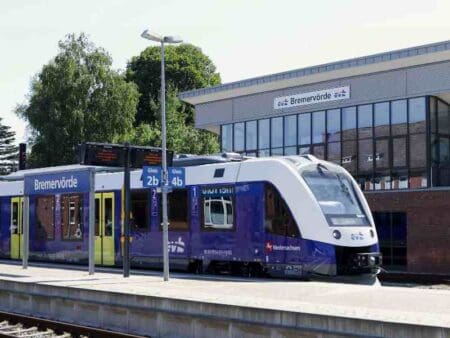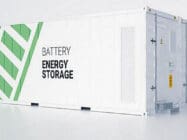
Germany has launched a passenger railway network of Coradia iLint model trains, powered entirely by hydrogen, stated to be a world-first. The 14 trains belong to the Landesnahverkehrsgesellschaft Niedersachsen (LNVG) mbH, a subsidiary of the state.
The trains are run on the route between Cuxhaven, Bremerhaven, Bremervörde and Buxtehude, operated by Elbe-Weser Transport Company (EVB) on behalf of LNVG, replacing 15 prior diesel trains. Five of the new trains are currently rolling and the rest will be added by the end of 2022.
The units come in as LNVG has been exploring diesel alternatives for trains since 2012 and are the result of a partnership with rail vehicle manufacturer Alstom, transport company Elbe-Weser (evb) and gases and engineering company Linde.
According to LNVG, each of the models are quiet, powered by a hydrogen fuel cell that generates electrical energy for propulsion. The Coradia iLint features clean energy conversion, flexible energy storage in batteries and intelligent management of automotive power and energy.
Have you read:
The hydrogen smart meter business case
Technology Trending: utility drones, AI edge computing, hydrogen blending, carbon capture materials
First battery powered trains for Denmark
Developed specifically for use on non-electrified routes, the train travels on the evb network at speeds of 80 to 120km/h, with a top speed of 140km/h.
LNVG has stated that the models are entirely emission-free. One kilogram of hydrogen replaces around 4.5 litres of diesel fuel, translating to 1.6 million annual litres of diesel no longer consumed and 4,400 tons of CO2 no longer generated. Each is supplied at a hydrogen filling station around the clock, with one tank providing a range of 1,000km.
Hydrogen refilling station
Refilling the trains is taking place at a Linde facility in Bremervörde, which includes sixty-four 500-bar high-pressure storage tanks with a total capacity of 1,800kg, six hydrogen compressors and two fuel pumps.
Subsequent plans for the site include hydrogen production using electrolysis and renewable electricity alongside corresponding expansion of the area itself.
The project was funded by the Federal Ministry for Digital Affairs and Transport as part of Germany‘s National Innovation Program for Hydrogen and Fuel Cell Technology. It cost a total of €93 million ($93.4 million).
The federal government contributed €8.4 million ($8.5 million) to cover vehicle costs and €4.3 million ($4.3 million) for the filling station. The funding guideline is coordinated by NOW GmbH and implemented by the project management agency Jülich (PtJ).








